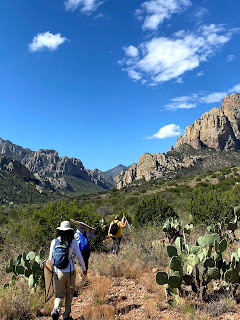
Yesterday, we spent time in the field collecting specimens within a plot of Juniper Monosperma trees. Today we started our day in the classroom with a talk by Dr. Lee Dyer. The research we are helping with is being conducted in Arizona, Ecuador, Nevada, Florida, and Costa Rica and has been going on for decades. The project we are working on with Dr. Lee Dyer and PhD student Dani Salcedo studies natural enemies of caterpillars that are called "parasitoids." These include many species of wasps and flies that kill caterpillars by depositing their eggs IN or ON the caterpillar. This ensures that the parasitoids' offspring will have a safe place to grow (inside the caterpillar) and plenty of food to eat (caterpillar tissue). The research being conducted by Dr. Lee Dyer has spanned decades. It includes the rearing of over 300 species of caterpillars, caring for them, recording data and recording the mortality rate caused by parasitoids. By comparing results from the different research site locations, the hypotheses about the effects of climate change on interactions between caterpillars and parasitoids can be tested.

This morning started with work time in the lab. We rotated jobs and could choose what we would like to work on. Some of us took photographs of the collected caterpillars. It really is exciting to use these super cool high-tech cameras with intense power to zoom into the smallest of caterpillars and capture even the tiniest of hairs on them. It's WAY harder than it seems. The caterpillars can be super tiny and move all over - so capturing these photos takes both time and patience.
Some of us did "zoo" which was our animal husbandry station. What do you do to take care of an animal? Feed it and clean its poop. Yep. We did that for all the caterpillars. We gave them fresh host plants and cleaned (and collected) their poop. This station was particularly interesting. I mean, I know my 5th graders would love to hear me share about ANYTHING poop related. So, let's get to the fun part. Caterpillar poop. First of all, caterpillar poop is called frass. As Dr. Lee Dyer shared today - pooping in nature is dangerous. It is dangerous as predators can smell and detect your location. Some caterpillars have super unique ways of dealing with their poop. Some roll up leaves and poop inside their little leaf home. Yep. They live all up in a curled leaf with their poop in there with them. Why? It doesn't leave a trail for predators to see. However, it does create a smell that can be a sure tip off to parasitoids. Those wasps or flies that are parasitoids can smell them and parasitize them in their leaf homes. Other caterpillars have anal oars that shoot their poop super far out behind them so that it isn't anywhere close to their home to be a dead give away. Other caterpillars actually reach around, grab their poop and fling it FORWARD away from them. Yep. This is all scientific fact.
Today, as part of our zoo time, we actually collected the caterpillar poop. We put them into tiny vials to be tested. There is a lot to be learned from poop. Dr. Lee Dyer's wife is actually running a side study that is collecting data to study a horrible virus that has been spreading in caterpillars. This virus has been deadly to caterpillars and there is still much that is unknown about the virus. Dr. Lee Dyer's wife is collecting the caterpillar poop in order to extract DNA from the poop to be able to tell which caterpillars have been infected with the virus and where the virus has spread to. Super interesting. Our job was collecting it, writing the specimen number and then giving fresh host plants for the caterpillar to munch on. Of course, sometimes we would catch something cool - like a caterpillar that had pupated already - or, in some cases, had been parasitized. We would open the cup and find a wasp or a fly instead of a caterpillar. All the caterpillars are meticulously numbered for the order they were found. Their host plant is noted on the collection cup, along with the date and specific location.

“Be the change you want to see in the world.” – Ghandi
“Action without vision is only passing time;
Vision without action is merely day dreaming;
But vision with action can change the world.” – Nelson Mandela
We are grateful to Earthwatch for this experience. We are grateful for the people here at Cave Creek Ranch in Arizona that are taking such great care of us. We are thankful for the mild weather. I know that when I heard the word "Arizona" I expected blistering heat. It has been very nice weather! Mild in the morning, breezy, clear skies. It has even rained a little each day we have been here so far. Thankfully, it has always in the late afternoons when we are already back from field work. We are grateful for the rich diversity in both plant and animal life. We are grateful for beautiful accommodations nestled in the Chiricahua Mountains. We are grateful for each other, our commitment to education and the environment. It already feels like we are a family. Although we leave this beautiful place tomorrow, we are headed to another research site in Arivaca, AZ.
Stay tuned for our adventures!








Comments
Post a Comment